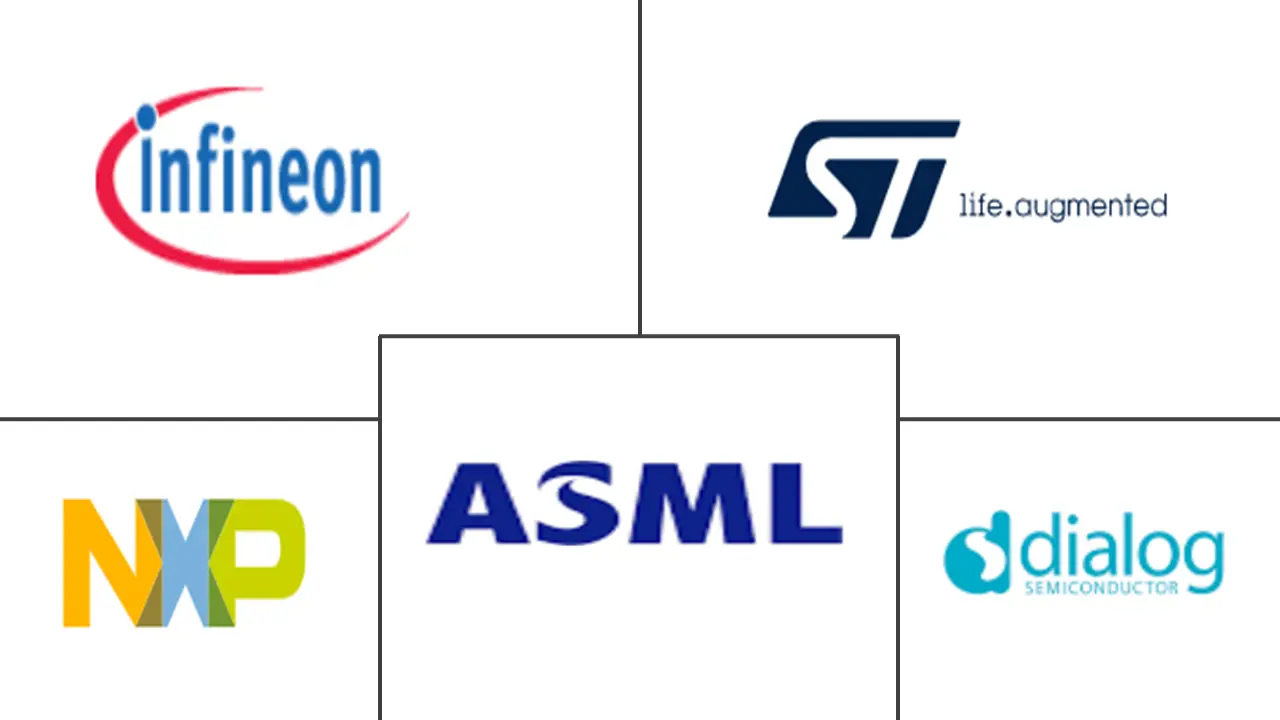Europe Semiconductor Device in Consumer Market Size
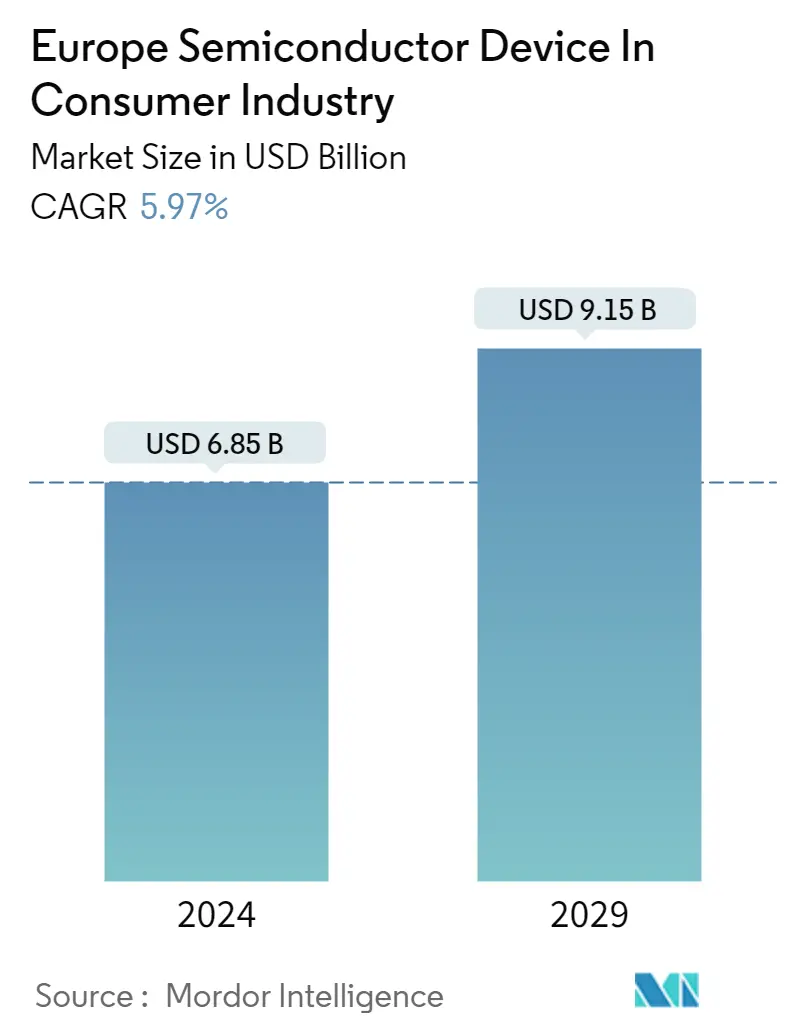
| Study Period | 2019 - 2029 |
| Base Year For Estimation | 2023 |
| Market Size (2024) | USD 6.85 Billion |
| Market Size (2029) | USD 9.15 Billion |
| CAGR (2024 - 2029) | 5.97 % |
| Market Concentration | Medium |
Major Players*Disclaimer: Major Players sorted in no particular order |
Europe Semiconductor Device in Consumer Market Analysis
The Europe Semiconductor Device In Consumer Industry is expected to grow from USD 6.85 billion in 2024 to USD 9.15 billion by 2029, at a CAGR of 5.97% during the forecast period (2024-2029).
Europe is home to an established consumer electronic sector supported by a robust high-tech interconnectivity environment. Demand for consumer electronic products is changing due to technological advances and trends in smart offices and homes, which is anticipated to excel in the market growth during the forecast period.
- The bulk of consumer electronic devices contain semiconductors. Semiconductor parts, including integrated circuits, diodes, and transistors, are used in appliances like microwaves, refrigerators, computers, gaming consoles, and mobile phones. The semiconductor materials used in power electronics directly impact the system's efficiency.
- The consumer electronics industry in Europe is expected to expand significantly over the following years due to the region's high internet penetration. The demand for innovative wearable technology and devices will rise as smartphone usage grows.
- In addition, many consumers are switching from semi-automatic to completely automated household appliances to improve their quality of life. With annual increases in per capita income, Germany, the United Kingdom, and France are just a few of the many nations that have increased demand for tiny electric appliances. These trends will be the emerging factors for driving market growth.
- In the post-COVID-19 scenario, the growing demand for consumer electronics goods and rapid adoption of 5G cellular networks will create the opportunity to develop new 5G-enabled smartphones, propelling the market growth in the projected period. As a result of the European Chips Act and other subsidy programs, supply chain stability, semiconductor flexibility, and increased innovation will help the industry in the coming years.
- Re-globalizing the supply chain will increase its resilience and reduce the likelihood of future shortages by dispersing it across the EU region. This may give the Consumer Electronics industry access to innovative chipsets with smaller form factors, artificial intelligence (AI) capabilities, and a reliable supply of the semiconductors needed for product roadmaps.
Europe Semiconductor Device in Consumer Market Trends
Rising Demand for Consumer Electronics Products to Drive the Market Growth
- Semiconductors are crucial parts of electronic devices and are also utilized in electronic systems that make it possible for infrastructure to run. Daily, more than 100 billion semiconductors are consumed in the industry. More than one type of semiconductor will almost certainly be present in an electrical product. For instance, a smartphone uses many semiconductors for processing, display, facial recognition, and connectivity (like 5G) functions.
- Since a sizable portion of the population in Europe has a high per capita income, they desire things that are in keeping with their opulent way of life. The demand for household appliances with Bluetooth and Wi-Fi connectivity has increased. Customers' interest in smart homes is growing as businesses introduce goods with premium features. The ability of intelligent refrigerators, microwaves, and air conditioners to effortlessly link to a customer's smartphone and enable remote monitoring of the appliances has significantly raised the demand for these products in recent years.
- The consumer electronics market in Europe will continue to expand over the next several years as consumers' demand for home products connected to smartphones increases significantly. Wearable technology is becoming more popular among people to accurately assess their overall health and fitness.
- The gaming consoles typically operate with semiconductors such as integrated chips, etc. The increasing adoption of consoles can play a significant factor in the market growth. Furthermore, gaming consoles are the third most popular home entertainment system after televisions and DVD players. For example, most markets with the highest penetration of video game consoles are in Europe. 33% of adults in the United Kingdom can access a gaming console.
- The use and development of communications infrastructure (such as 5G and 6G), artificial intelligence, smart devices that communicate data over a network (Internet of Things), and the transition to Research & development (R&D) are all expected to increase demand for semiconductors significantly in the region.
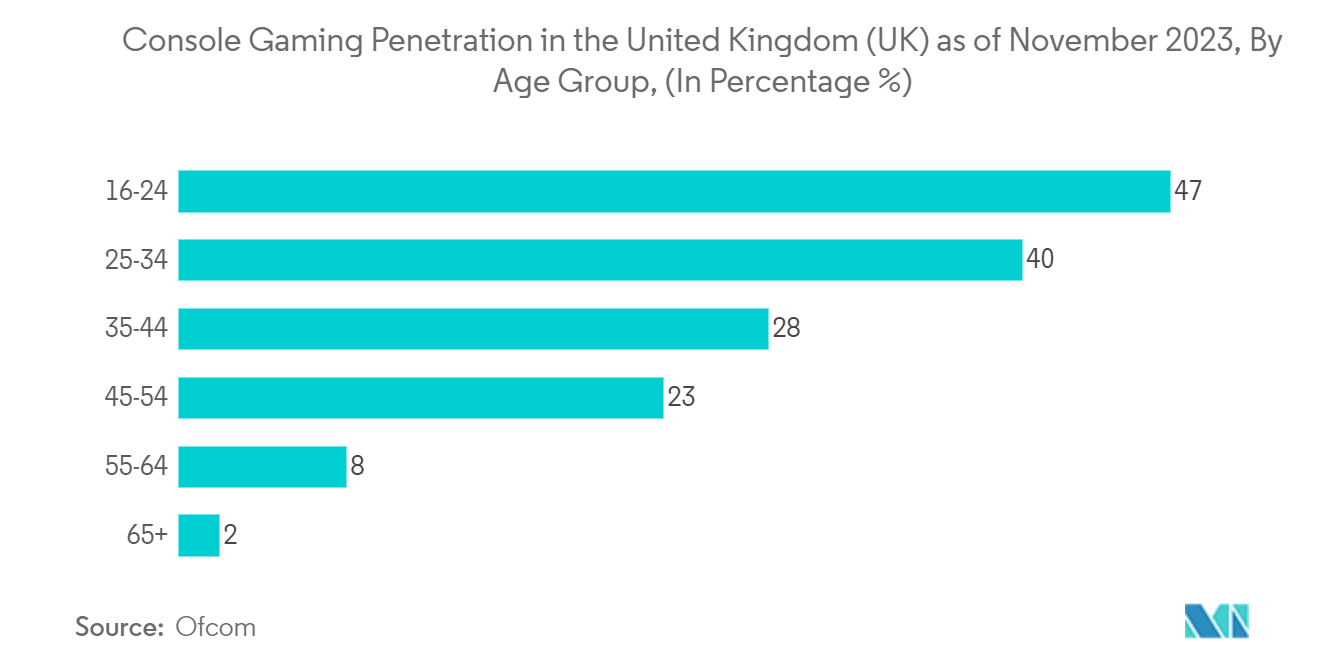
United Kingdom Region to Grow Significantly
- The usage of smart home appliances is expanding in the country as more people embrace technology to improve their lifestyles. Hence, reputed companies are adopting partnerships as their core strategies to boost intelligent home adoption in the country. For instance, in October 2023, HMD Global, the Finnish company known for the Nokia brand, launched European-manufactured smartphone. This strategic step follows HMD Global's announcement six months ago, outlining its shift towards European manufacturing. The pivot was a response to rising enterprise demand for locally sourced hardware, driven by concerns over security and sustainability.
- To test compatible responses to demand, including through smart meters and energy management systems, the United Kingdom announced a program on energy intelligent appliances in 2022. Under this program, using energy-smart devices will aid the shift to a flexible and low CO2 energy system. The power demand will change, becoming more flexible to meet the near-term renewable energy supply. This will enable customers to actively regulate the market and significantly advance the UK's transition to net zero.
- The United Kingdom government projects that 2024 there will be over 150 million IoT devices in the country. Over 40% of all IoT connections come from the white goods industry and consumer wearables. The most popular category will be smartwatches and ear-worn fitness and health monitors. Smartwatches comprise several semiconductor materials and are frequently utilized as many measure their heart rates and monitor their health. In the UK's 2023 survey, it has been identified that 22% of respondents use smartwatches for personal use. This is anticipated to excel in the market growth during the projected period.
- Given the advantages smartwatches and other wearables offer, particularly to older adults, demand for these gadgets and the aging population is rising dramatically. For instance, Fitbit United Kingdom sells the Sense wristwatch, which, according to the firm, uses a cutting-edge environmental data acquisition (EDA) sensor to help customers manage stress. These trends will propel the market growth during the projected period.
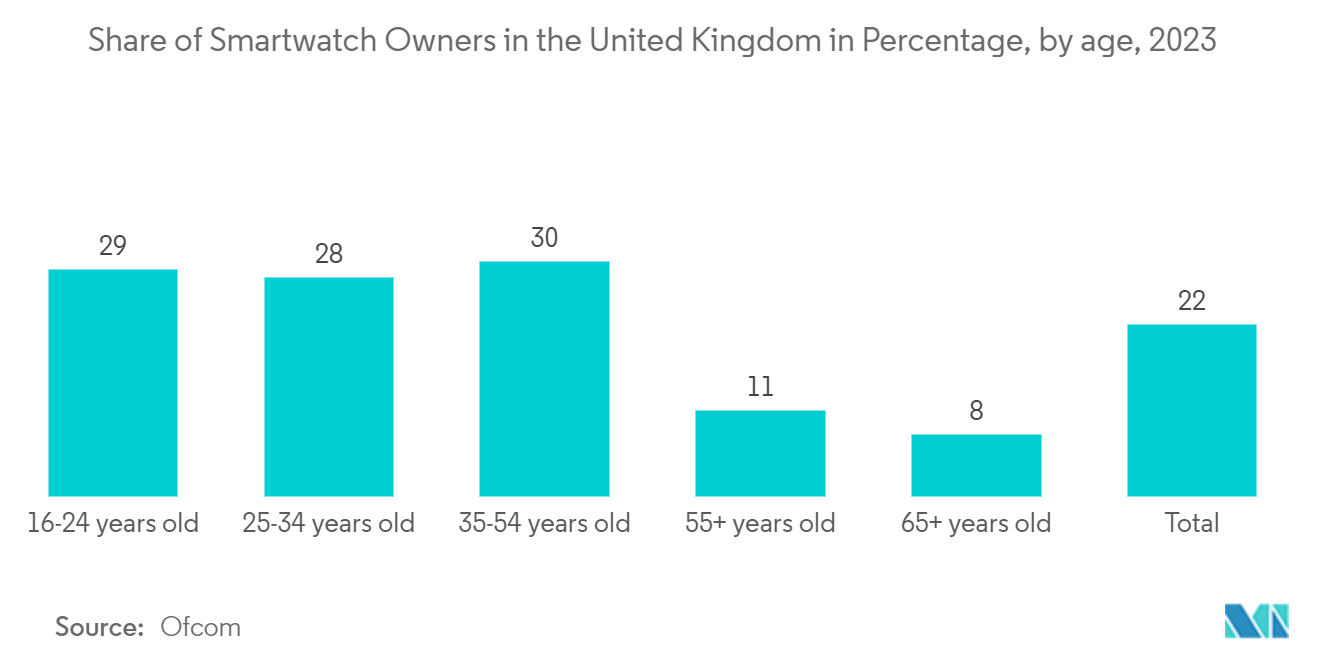
Europe Semiconductor Device in Consumer Industry Overview
In the European consumer semiconductor device market, a select group of global industry leaders exert substantial influence. This market exhibits a moderate level of consolidation, characterized by ongoing innovation and collaborative efforts among key players to secure and expand their market share. Prominent companies in this domain include Infineon Technologies AG, STMicroelectronics, NXP Semiconductors, ASML Holding N.V., Dialog Semiconductor (now a part of Renesas Electronics), and more.
- In May 2023, Infineon Technologies AG introduced the WLC1150 wireless charging transmitter IC to enhance its range of wireless charging (WLC) controller ICs. This addition offers a highly integrated, user-friendly, and cost-effective solution, catering to applications demanding increased wireless power transmission, such as smartphone chargers. Notably, this solution complies with the Qi Extended Power Profile (EPP).
- In January 2023, NuCurrent joined forces with Infineon Technologies AG as a Preferred Partner. This strategic partnership aims to enhance the capabilities and scalability of near-field communication (NFC) technology for energy collection and charging applications. Infineon's NFC tag-side controllers, equipped with integrated H-bridge and energy harvesting modules, provide a single-chip solution for creating economical, compact actuation or sensing applications that can operate in passive or active mode. The initial focus of The Preferred Partnership centers on the Energy Harvesting actuator and sensor ICs offered by Infineon.
Europe Semiconductor Device in Consumer Market Leaders
-
Infineon Technologies AG
-
STMicroelectronics
-
NXP Semiconductors
-
ASML Holding N.V.
-
Dialog Semiconductor (Renesas Electronics)
*Disclaimer: Major Players sorted in no particular order
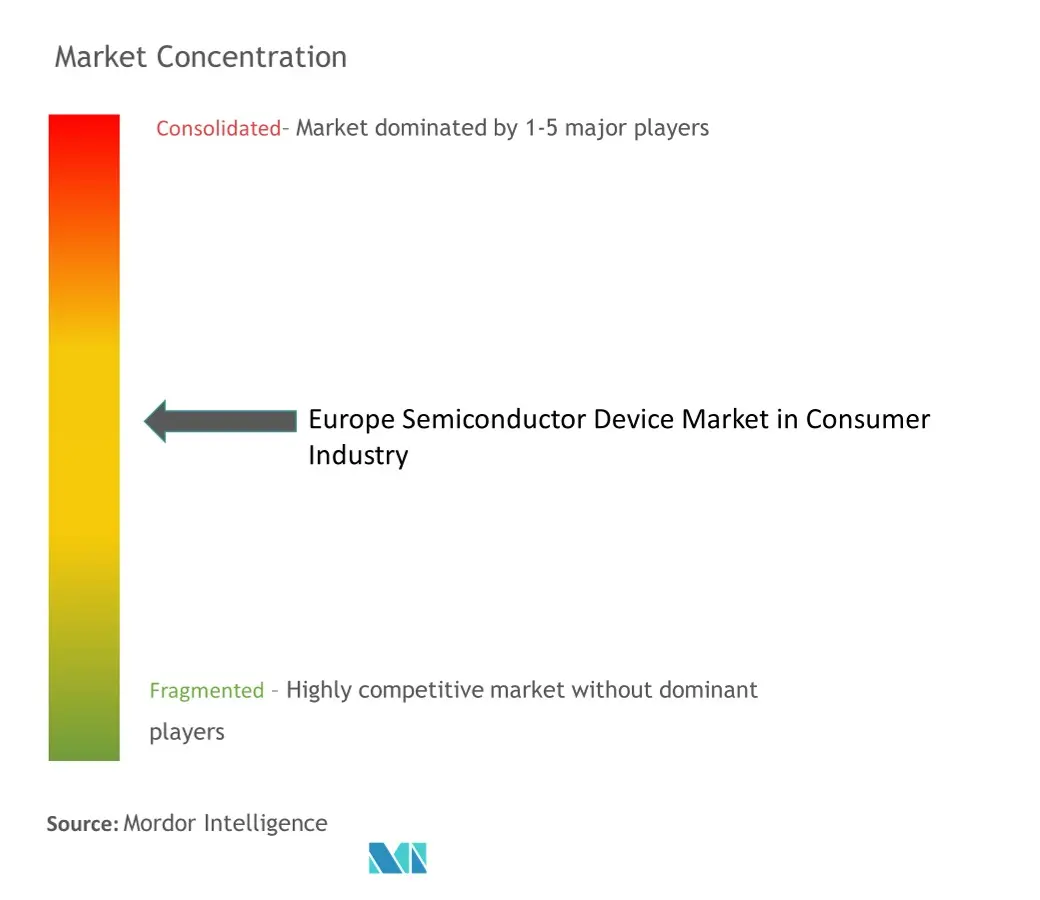
Europe Semiconductor Device in Consumer Market News
- September 2023 - DXCM launched its DexCom ONE continuous glucose monitoring (CGM) system in France, catering to individuals with diabetes. This new addition to the company's sensor lineup is now part of France's reimbursement packages, ensuring an accessible and efficient diabetes management solution.
- June 2023 - Intel, launched its choice for the location of a advanced semiconductor assembly and test facility - near Wrocław, Poland. This strategic move is in response to the rising demand for assembly and test capacity, a demand Intel foresees peaking by 2027. Moreover, the construction phase is expected to not only create thousands of jobs but also trigger further hiring by associated suppliers.
Europe Semiconductor Device In Consumer Industry Market Report - Table of Contents
1. INTRODUCTION
- 1.1 Study Assumptions and Market Definition
- 1.2 Scope of the Study
2. RESEARCH METHODOLOGY
3. EXECUTIVE SUMMARY
4. MARKET INSIGHTS
- 4.1 Market Overview
-
4.2 Porter's Five Forces Analysis
- 4.2.1 Bargaining Power of Suppliers
- 4.2.2 Bargaining Power of Buyers
- 4.2.3 Threat of New Entrants
- 4.2.4 Threat of Substitutes
- 4.2.5 Intensity of Competitive Rivalry
- 4.3 Industry Value Chain/Supply Chain Analysis
- 4.4 Assessment of the Impact of Macro Trends on the market
5. MARKET DYNAMICS
-
5.1 Market Drivers
- 5.1.1 Rising Demand for Consumer Electronics Products
- 5.1.2 Growing Adoption of Innovative Technologies like Consumer IoT
-
5.2 Market Restraints
- 5.2.1 Semiconductor Chip Supply Shortage
6. MARKET SEGMENTATION
-
6.1 Device Type
- 6.1.1 Discrete Semiconductors
- 6.1.2 Optoelectronics
- 6.1.3 Sensors
- 6.1.4 Integrated Circuits
- 6.1.4.1 Analog
- 6.1.4.2 Logic
- 6.1.4.3 Memory
- 6.1.4.4 Micro
- 6.1.4.4.1 Microprocessor
- 6.1.4.4.2 Microcontroller
- 6.1.4.4.3 Digital Signal Processors
-
6.2 Country
- 6.2.1 United Kingdom
- 6.2.2 Germany
- 6.2.3 France
7. COMPETITIVE LANDSCAPE
-
7.1 Company Profiles
- 7.1.1 Infineon Technologies AG
- 7.1.2 STMicroelectronics
- 7.1.3 NXP Semiconductors
- 7.1.4 ASML Holding N.V.
- 7.1.5 Dialog Semiconductor (Renesas Electronics)
- 7.1.6 X-FAB Silicon Foundries
- 7.1.7 AMS AG (Austria)
- 7.1.8 SGS SA
- 7.1.9 SOITEC SA
- 7.1.10 Advanced Semiconductor Engineering Inc.
- *List Not Exhaustive
8. INVESTMENT ANALYSIS
9. FUTURE OUTLOOK OF THE MARKET
** Subject To AvailablityEurope Semiconductor Device in Consumer Industry Segmentation
A semiconductor is a substance whose electrical conductivity is intermediate between that of an insulator like rubber and that of a pure metal (or conductor), such as copper. A semiconductor is distinguished by its ability to regulate electrical flow's direction, pace, and location. They are ideal for use as transistors or switches. The fundamental component of contemporary computer chips is the transistor.
The European semiconductor device market in the consumer industry is segmented by device type (discrete semiconductors, optoelectronics, sensors, and integrated circuits (analog, logic, memory, and micro (microprocessors, microcontrollers, and digital signal processors))) and by country (UK, France, Germany, and the rest of Europe).
The market sizes and forecasts are provided in terms of value in USD for all the above segments.
| Device Type | Discrete Semiconductors | ||
| Optoelectronics | |||
| Sensors | |||
| Integrated Circuits | Analog | ||
| Logic | |||
| Memory | |||
| Micro | Microprocessor | ||
| Microcontroller | |||
| Digital Signal Processors | |||
| Country | United Kingdom | ||
| Germany | |||
| France |
Europe Semiconductor Device In Consumer Industry Market Research FAQs
How big is the Europe Semiconductor Device In Consumer Industry?
The Europe Semiconductor Device In Consumer Industry size is expected to reach USD 6.85 billion in 2024 and grow at a CAGR of 5.97% to reach USD 9.15 billion by 2029.
What is the current Europe Semiconductor Device In Consumer Industry size?
In 2024, the Europe Semiconductor Device In Consumer Industry size is expected to reach USD 6.85 billion.
Who are the key players in Europe Semiconductor Device In Consumer Industry?
Infineon Technologies AG, STMicroelectronics, NXP Semiconductors, ASML Holding N.V. and Dialog Semiconductor (Renesas Electronics) are the major companies operating in the Europe Semiconductor Device In Consumer Industry.
What years does this Europe Semiconductor Device In Consumer Industry cover, and what was the market size in 2023?
In 2023, the Europe Semiconductor Device In Consumer Industry size was estimated at USD 6.44 billion. The report covers the Europe Semiconductor Device In Consumer Industry historical market size for years: 2019, 2020, 2021, 2022 and 2023. The report also forecasts the Europe Semiconductor Device In Consumer Industry size for years: 2024, 2025, 2026, 2027, 2028 and 2029.
Europe Semiconductor Device In Consumer Industry Report
Statistics for the 2024 Europe Semiconductor Device In Consumer Industry market share, size and revenue growth rate, created by Mordor Intelligence™ Industry Reports. Europe Semiconductor Device In Consumer Industry analysis includes a market forecast outlook to for 2024 to 2029 and historical overview. Get a sample of this industry analysis as a free report PDF download.

